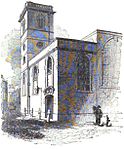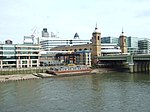Cannon Street station rail crash
1991 disasters in the United Kingdom1991 in LondonAccidents and incidents involving Network SouthEastJanuary 1991 events in the United KingdomRail accidents caused by a driver's error ... and 4 more
Railway accidents and incidents in LondonRailway accidents in 1991Transport in the City of LondonUse British English from March 2017

The Cannon Street station (London) rail crash occurred on 8 January 1991, when a packed commuter train failed to stop and collided with the buffers, killing two and injuring 542. The cause was driver error, compounded by ageing wooden carriages.
Excerpt from the Wikipedia article Cannon Street station rail crash (License: CC BY-SA 3.0, Authors, Images).Cannon Street station rail crash
Upper Thames Street, City of London
Geographical coordinates (GPS) Address Nearby Places Show on map
Geographical coordinates (GPS)
| Latitude | Longitude |
|---|---|
| N 51.510555555556 ° | E -0.090555555555556 ° |
Address
London Cannon Street
Upper Thames Street
EC4R 2GA City of London
England, United Kingdom
Open on Google Maps










